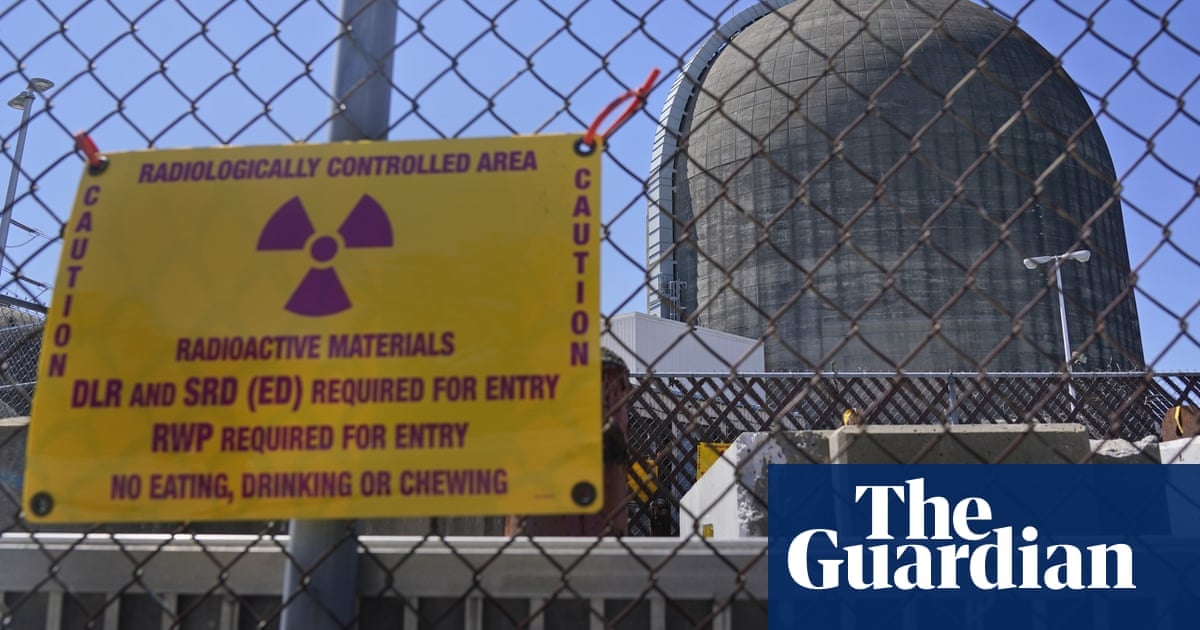Shuttering of New York facility raises awkward climate crisis questions as gas – not renewables – fills gap in power generation
When New York’s deteriorating and unloved Indian Point nuclear plant finally shuttered in 2021, its demise was met with delight from environmentalists who had long demanded it be scrapped.
But there has been a sting in the tail – since the closure, New York’s greenhouse gas emissions have gone up.
Castigated for its impact upon the surrounding environment and feared for its potential to unleash disaster close to the heart of New York City, Indian Point nevertheless supplied a large chunk of the state’s carbon-free electricity.
Since the plant’s closure, it has been gas, rather then clean energy such as solar and wind, that has filled the void, leaving New York City in the embarrassing situation of seeing its planet-heating emissions jump in recent years to the point its power grid is now dirtier than Texas’s, as well as the US average.



Here is a copypasta from another user:
*When it comes to generating electricity, nuclear is hugely more expensive than renewables. Every 1000Wh of nuclear power could be 2000-3000 Wh solar or wind.
If you’ve been told “it’s not possible to have all power from renewable sources”, you have been a victim of disinformation from the fossil fuel industry. The majority of studies show that a global transition to 100% renewable energy across all sectors – power, heat, transport and industry – is feasible and economically viable.
This is all with current, modern day technology, not with some far-off dream or potential future tech such as nuclear fusion, thorium reactors or breeder reactors.
Compared to nuclear, renewables are:
Nuclear power has promise as a future technology. But at present, while I’m all in favour of keeping the ones we have until the end of their useful life, building new nuclear power stations is a massive waste of money, resources, effort and political capital.
Nuclear energy should be funded only to conduct new research into potential future improvements and to construct experimental power stations. Any money that would be spent on building nuclear power plants should be spent on renewables instead.
Frequently asked questions:
While a given spot in your country is going to have periods where it’s not sunny or rainy, with a mixture of energy distribution (modern interconnectors can transmit 800kV or more over 800km or more with less than 3% loss) non-electrical storage such as pumped storage, and diversified renewable sources, this problem is completely mitigated - we can generate wind, solar or hydro power over 2,000km away from where it is consumed for cheaper than we could generate nuclear electricity 20km away.
The United States has enough land paved over for parking spaces to have 8 spaces per car - 5% of the land. If just 10% of that space was used to generate solar electricity - a mere 0.5% - that would generate enough solar power to provide electricity to the entire country. By comparison, around 50% of the land is agricultural. The amount of land used by renewable sources is not a real problem, it’s an argument used by the very wealthy pro-nuclear lobby to justify the huge amounts of funding that they currently receive.
No, it’s dirtier. You can look up total lifetime emissions for nuclear vs. renewables - this is the aggregated and equalised environmental harm caused per kWh for each energy source. It takes into account the energy used to extract raw materials, build the power plant, operate the plant, maintenance, the fuels needed to sustain it, the transport needed to service it, and so on. These numbers always show nuclear as more environmentally harmful than renewables.
Not according to industry experts - the majority of studies show that a 100% renewable source of energy across all industries for all needs - electricity, heating, transport, and industry - is completely possible with current technology and is economically viable. If you disagree, don’t argue with me, take it up with the IEC. Here’s a Wikipedia article that you can use as a baseline for more information: https://en.m.wikipedia.org/wiki/100%25_renewable_energy *
Here is some info about the only construction projects in the US from the last 25 years:
The V.C. Summer project in South Carolina (two AP1000 reactors) was abandoned after the expenditure of at least A$12.5 billion leading Westinghouse to file for bankruptcy in 2017.
Vogtle project in Georgia (two AP1000 reactors). The current cost estimate of A$37.6-41.8 billion is twice the estimate when construction began. Costs continue to increase and the project only survives because of multi-billion-dollar taxpayer bailouts. The project is six years behind schedule.
The Watts Bar 2 reactor in Tennessee began operation in 2016, 43 years after construction began. That is the only power reactor start-up in the US over the past quarter-century. The previous start-up was Watts Bar 1, completed in 1996 after a 23-year construction period.
In 2021, TVA abandoned the unfinished Bellefonte nuclear plant in Alabama, 47 years after construction began and following the expenditure of an estimated A$8.1 billion.
More information
who the fuck is downvoting this?
I’d really rather put all that money and effort into developing fusion power plants. In 20 or 30 years, we should actually be building commercial ones. And the promise of that is far beyond anything nuclear plants could ever deliver.
I can see, maybe, building a few more nuclear plants to cover the gap, but a widespread effort to build many more new ones? The resources for that really up to go elsewhere.
But, with regards to the Indian point power plant, the plant was shut down because it was old and damaged and leaking into the local environment. That particular plant very much needed to be shut down, not because it was a nuclear power plant, just because that particular plant was too old and broken to continue safe operation.
We don’t have 20-30 years to wait for a “maybe”.
We need to drastically reduce emissions yesterday. The way to do that is water, wind, solar.
That’s why we’re investing in renewable green energy in the meantime. Any new nuclear power plant would take a decade to build at least. They don’t just pop up overnight.
Well, no. It’s not feasible because of lack of energy storage. There is no way you would power from renewables through winter with current technology. Period. Ask Germans, one of the most renewable countries in Europe and one of the biggest pollutors at same time.
If we invent energy storage for such large scale then it’s just a matter of building plenty of sources.
Germany right now has about 60-70% renewable electricity in the summer and about 50% renewable in winter. 100% is absolutely achievable. You need to install more capacity than you need of course and there will be times where you generate much more power than you need. That is not a problem because a) renewables are cheap to install and b) you can use that excess power to charge batteries or synthesize hydrogen.
Those in turn can be used for times where power production might now be enough otherwise. We have the technology, we are deploying it right now and by the time the last coal plants are shut down, it will work.
If we start building nuclear power today, we get less capacity slower for a higher price.
So, why don’t they have storage then, if it is easy? I also doubt 50% during winter when clouds and short days. Summer is not a problem, winter is when everybody is consuming a lot of energy for heating.
There is not a lot of storage yet because the goal is only to be climate neutral by 2045 and right now, more power generation has the priority. There are limited funds.
I never said it was easy. I said it was more economically viable than constructing dozens of nuclear reactors.
On the contrary, it’s one of the biggest economic transitions ever.
Wind turbines make up the biggest share of regenerative capacity in the German power grid and there tends to be more wind in winter:
Sorry it’s not the best diagram and it’s in German.
The numbers appear to be TWh of power (that’s why it doesn’t add up to 100). The percentage above each month is the percentage of regenerative sources. 2023 it never dropped beneath 50% except 47 in February.
How much of those costs are due to obstructionism by anti-nuclear folks like yourself?
Also, breeder reactors are not “potential future tech”. There are numerous contemporary breeder reactors designs, and the very first nuclear reactor to generate grid power in the United States was a breeder reactor.
If you have any data at all that shows that the price is a function of regulation, I would encourage you to share it.
Nuclear costs orders of magnitude more than renewables. You need to offer strong evidence to account for that difference being due to regulation.
I never said the cost of nuclear was a function of regulation. I do believe that NIMBYism has a lot to do with it.
The thesis of your remarks seems to indicate that you think that nuclear power generation is inherently more expensive, and I’d be interested in hearing your non-circular reasoning for that implicit assertion. So far, all I’ve heard is “Nuclear is more expensive because it is.”
A study by MIT in 2020 found that most of the excessive costs related to building nuclear plants are due to lack of decent standardization. Part of the problem is that because of emotional opposition to nuclear, the industry has had little opportunity to actually deploy any of the modular reactor innovations that have been developed in the last 50 years.
Here’s a link to the MIT article: https://news.mit.edu/2020/reasons-nuclear-overruns-1118
Again, I’m interested in hearing your reasoning for why nuclear is more expensive, other than “it just is” and “renewables are better”.
My reasoning is based on the about 80 years of history we have building these.
They did sort of standardize around some reactor designs, and nothing is or was stopping companies from forming consortiums to reducing R&D and manufacturing costs.
They have had 80 years to do it and they have not. Nuclear is very, very challenging power generation that has an easy side of runaway reaction, not a low cost mix of things.
Nuclear has had plenty of time to prove itself and to lower its costs. It has failed to do so and renewables and storage are now so cheap that nuclear no longer makes any real sense.
But yeah, I doubt we are changing each other’s minds.